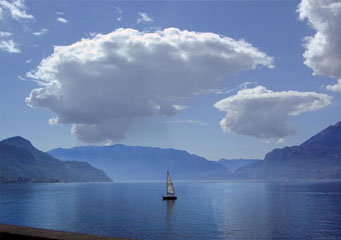
Above: Cumulus Virga
Cumulus Virga
The term 'virga' is a generic word to define the physicality of a particular cloud formation. Virga clouds refer to supplementary features in the cloud that look like a rod or stripe which is the Latin meaning of the word. These are considered to be accessory clouds that are linked to the different cloud families that exist. Cumulus virga clouds are also responsible for cloud seeding. This is because it carries the small particles to different cloud formation.
What height are cumulus virga clouds found?
Since the cumulus virga is from the cumulus genus, therefore the formation of these clouds is most commonly seen from about 6,000 to 10,000 feet. As with all other cumulus clouds, the creation of the cumulus virga is subject to convection between the warm air and the water droplets or ice crystals that are in the stratosphere.
Classification of cumulus virga clouds
While virga clouds are not a category or genus by itself, in general there are different types of virga clouds that can fall into several different cloud formations. The virga formations can be seen in the following cloud formations :
- Cumulus virga
- Cumulonimbus virga
- Altocumulus virga
- Stratocumulus virga
- Cirrocumulus virga
- Nimbostratus virga
- Altostratus virga.
How are cumulus virga clouds formed?
As with all other cumulus clouds, the cumulus virga clouds are formed through convection between the warm ground air and the cool stratospheric air which may include water droplets and ice crystals.
However there are occasions when, if the cooler air from the stratosphere descends rapidly, there can be a microburst when it meets the rising warm air. This is a somewhat rare occurrence however it can be dangerous for aviation.
What do cumulus virga clouds look like?
These cumulus virga clouds are commonly known as fall-stripe or fall-streak clouds. This is because they generally look like streaks of rain or snow that hang down from the sky. They are usually found under other clouds and will gradually move lower to ground level until ultimately, they evaporate. Because cumulus virga clouds tend to be low-lying clouds, at sunset in particular, the effect can be very dramatic and beautiful.
How common are cumulus virga clouds?
The cumulus virga clouds are fairly common and can be seen anywhere in the world. The best times to view such cloud formations are at sunrise and sunset.
Where can I see cumulus virga clouds?
The cumulus virga clouds can be seen anywhere in the world. The best places to view such clouds however are in countries that enjoy a temperate climate and also in the desert. However the best time to observe such clouds are either during sunrise or sunset. This is because they reflect the light of the sun and look like long stringy trails or streaks in the sky. What is also interesting is that apparently virga clouds also happen on Venus, Mars and Jupiter. In these instances the cumulus virga clouds may be responsible for causing sulfuric acid rain on Venus and other weather anomalies.
